Make You Feel Love Again Sealevel
Miami'south fight confronting ascension seas
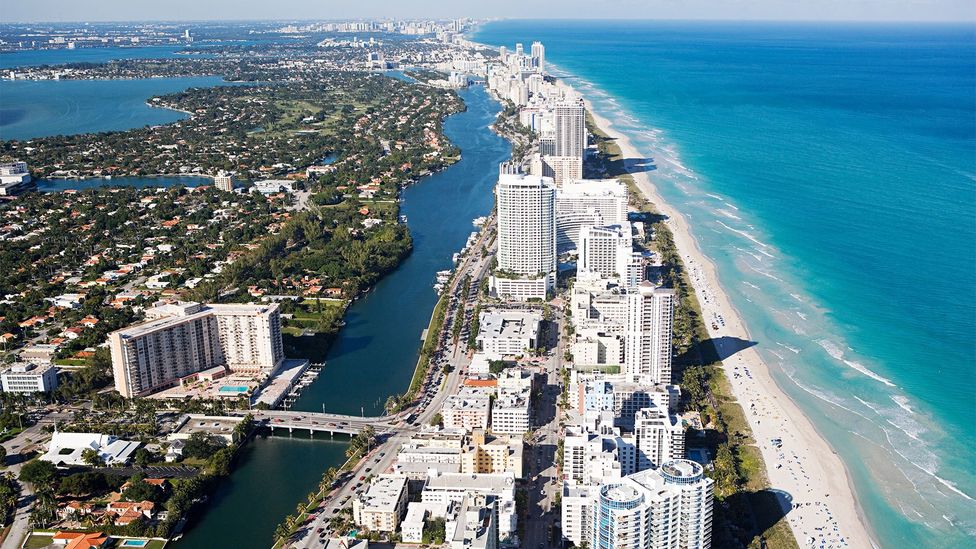
Just down the declension from Donald Trump's weekend retreat, the residents and businesses of south Florida are experiencing regular episodes of h2o in the streets. In the battle against rising seas, the region – which has more to lose than almost anywhere else in the world – is condign ground zero.

BBC Hereafter has brought you lot in-depth and rigorous stories to help you navigate the current pandemic, just nosotros know that's not all you want to read. So now we're dedicating a series to assist you escape. We'll be revisiting our nearly pop features from the last three years in our Lockdown Longreads .
You'll find everything from the story about the world's greatest space mission to the truth about whether our cats actually beloved us, the epic hunt to bring illegal fishermen to justice and the pocket-size squad which brings long-buried Earth State of war Two tanks back to life. What you won't find is any reference to, well, you-know-what. Savour.
The first time my father's basement flooded, it was shortly subsequently he moved in. The building was an ocean-front end high-rise in a small-scale metropolis north of Miami called Sunny Isles Embankment. The marble lobby had a waterfall that never stopped running; well-baked-shirted valets parked your automobile for you lot. For the residents who lived in the more than lavish flats, these cars were ofttimes BMWs and Mercedes. But no matter their value, the cars all wound upward in the same place: the basement.
When I called, I'd ask my dad how the building was doing. "The basement flooded again a couple weeks agone," he'd sometimes say. Or: "Information technology'southward getting worse." It's non only his building: he's also driven through a foot of water on a primary route a couple of towns over and is used to tiptoeing around pools in the local supermarket'due south machine park.
Ask nearly anyone in the Miami surface area virtually flooding and they'll have an anecdote to share. Many will also tell you that it's happening more and more often. The data backs them up.
Information technology's piece of cake to remember that the simply communities suffering from bounding main level ascent are far-flung and remote. And while places like the Solomon Islands and Republic of kiribati are indeed facing especially dramatic challenges, they aren't the just ones beingness forced to grapple with the upshot. Sea levels are rise effectually the world, and in the US, south Florida is ground nil – every bit much for the adaptation strategies it is attempting as for the risk that it bears.
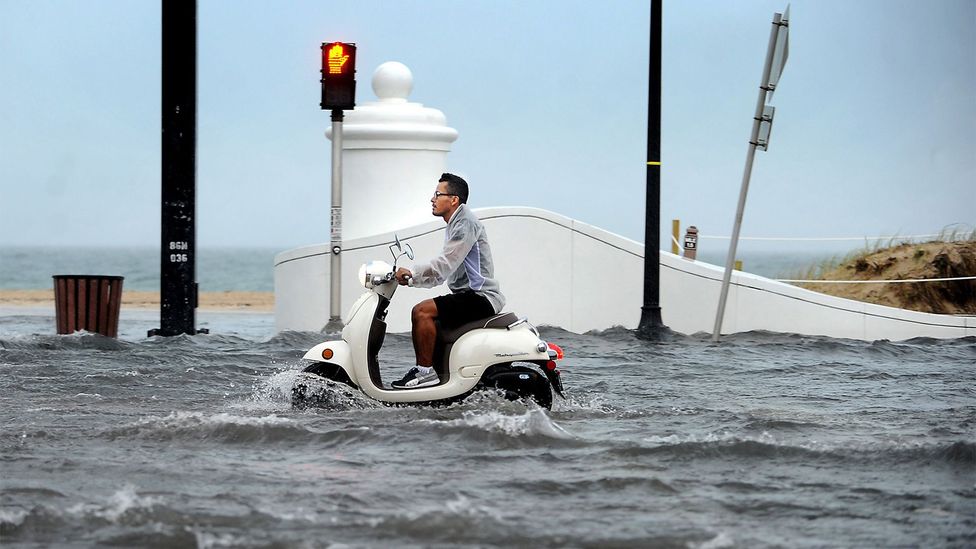
Florida Land Road A1A runs the entire length of Florida forth the ocean, making information technology vulnerable to flooding – as shown hither in Fort Lauderdale in 2013 (Credit: Alamy)
One reason is that water levels hither are rising peculiarly quickly. The most often-used range of estimates puts the likely range betwixt 15-25cm (6-10in) higher up 1992 levels by 2030, and 79-155cm (31-61in) by 2100. With tides higher than they have been in decades – and far college than when this swampy, tropical corner of the US began to be tuckered and built on a century agone – many of south Florida's drainage systems and seawalls are no longer plenty. That ways not only more flooding, but challenges for the infrastructure that residents depend on every twenty-four hours, from septic tanks to wells. "The consequences of body of water level ascension are going to occur manner before the high tide reaches your doorstep," says William Sweetness, an oceanographer at the National Oceanic and Atmospheric Assistants (NOAA).
The flooding would exist a challenge for whatever community, but it poses particular risks here. One recent written report estimated that Miami has the most to lose in terms of financial avails of whatever littoral urban center in the world, just above Guangzhou, China and New York City. This 120-mile (193km) corridor running up the coast from Homestead to Jupiter – taking in major cities similar Miami, Fort Lauderdale and West Palm Embankment – is the 8th nigh populous metropolitan expanse in the The states. It'due south also booming. In 2015, the Us Census Bureau plant that the population of all 3 counties here was growing – along with the rest of Florida – at around 8%, roughly twice the pace of the US average. Recent studies have shown that Florida has more residents at risk from climate alter than any other The states state.
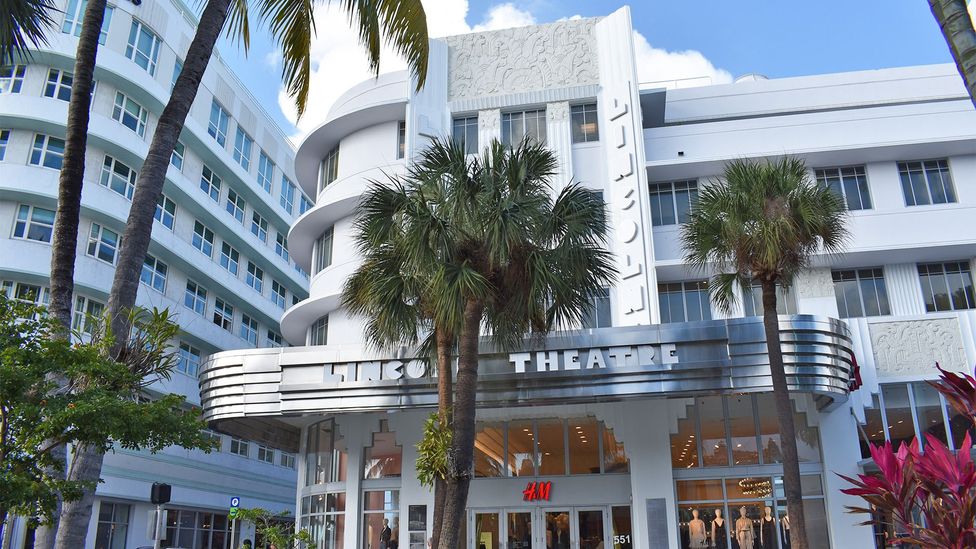
Forth with new developments, south Florida is home to historic properties which are at adventure, as in the Fine art Deco district of Miami Embankment (Credit: Amanda Ruggeri)
It has more belongings at adventure, too. In Miami-Dade Canton, developers had 1.6 million sq ft (149,000 sq yard) of role space and ane.eight million of retail space under construction in the second quarter of 2016 alone. Sunny Isles Beach, home to 20,300 people, has eight high-rise buildings under construction; swing a seagull in the air, and you'll hit a crane. Every bit yous might imagine, the value of development in this sun-soaked part of the country is high, as well. Property in Sunny Isles alone is at present worth more than than $10 billion. Many of the wealthiest people in the US reside in Florida, including 40 billionaires on the Forbes 400 listing of richest Americans; on a contempo calendar week, the virtually expensive real estate listing in the Usa was a $54 million mansion in Palm Beach.
Despite his history of referring to climate change equally a "hoax" and his recent rollback of emissions-slashing initiatives, President Donald Trump is one of these belongings owners with a stake in the event. The president frequently visits his Mar-a-Lago estate in Palm Beach, 75 miles (121km) northward of Miami, which is itself an expanse experiencing flooding from high tides. There also are six Trump-branded residential buildings in Sunny Isles, ane of which nonetheless provides the president with income, and a Trump-branded condominium complex in Hollywood.
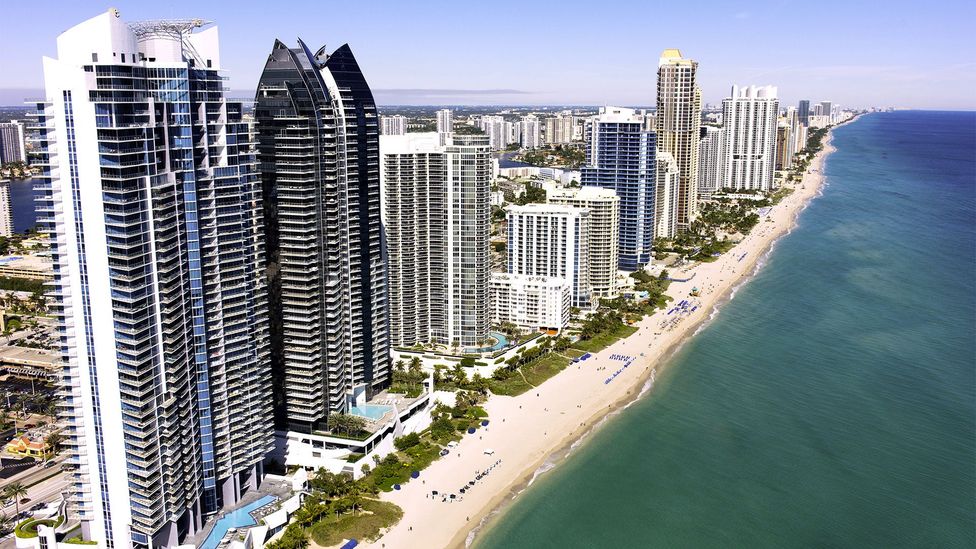
Sunny Isles Beach is habitation to $10 billion in property, including six Trump-branded buildings (Credit: Alamy)
Look beyond all the glass and steel, though, and – despite the federal government's sidelining of the issue – there's another thrum of action. Information technology's the wastewater treatment plant constructing new buildings 5 feet college than the erstwhile ones. The 105 miles (169km) of roads beingness raised in Miami Embankment. The new shopping mall congenital with inundation gates. The 116 tidal valves installed in Fort Lauderdale. The seawalls existence raised and repaired. And the worried conversations between more and more residents every twelvemonth about what the sea-rise models predict – and what to do about it.
The communities aren't brusk of solutions. "Nobody's doing ameliorate adaptation work in the country than south Florida," says Daniel Kreeger, executive director of the nonprofit Association of Climatic change Officers. Merely the question isn't whether this work will save every community: it won't. Even those tasked with making their cities resilient acknowledge that, at some point in the future, sure areas here will no longer be "viable" places to live. Rather, the challenge is to practise enough to ensure that the economic system as a whole continues to thrive and that tourists withal come to enjoy the sun, sand – and swelling sea.
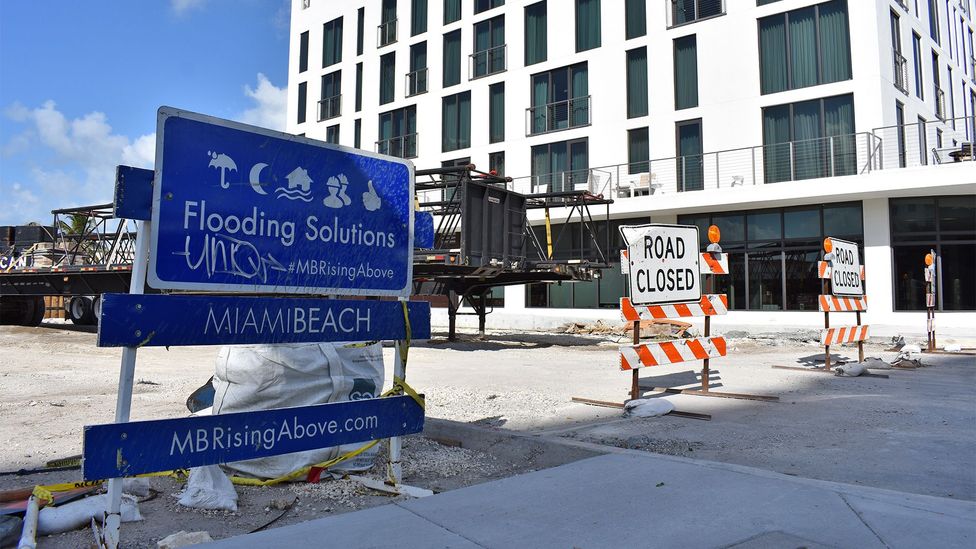
Signs similar these have get ubiquitous in Miami Beach, where officials are determined to fight flooding and have launched a multi-pronged plan (Credit: Amanda Ruggeri)
It'south a challenge that many officials and experts are determined to encounter. Getting in that location, though, requires a shift in how anybody from mayors to taxpayers, insurers to engineers, property developers to urban planners thinks nigh their communities – and the everyday decisions that shape them. The eyes of the world are on them: if ane of the richest communities on the planet can't step up, what hope is there for everyone else?
"If the science is correct on this – which it is going to be – the question is, 'How farthermost are the implications?'" says Kreeger. "We are literally going to have to rewrite how businesses function, and how cities are designed. Everything's going to change. And that'southward particularly going to be exacerbated in littoral communities.
"This would be no different than if I came to you and said 'Hey, in 40 years, gravity's going to change. I can't tell yous exactly what it's going to be. But let's presume roughly between 50% and lxxx% stronger or weaker than it is now.' You'd expect around and say 'Shoot, what'southward that going to affect?'
"And the answer is: information technology affects everything."
*
Body of water level ascent is global. Just due to a variety of factors – including, for this office of the Atlantic declension, a likely weakening of the Gulf Stream, itself potentially a upshot of the melting of Greenland'southward ice caps – southward Floridians are feeling the furnishings more than many others. While there has been a mean rise of a little more than 3mm per year worldwide since the 1990s, in the concluding decade, the NOAA Virginia Key tide gauge only s of Miami Beach has measured a 9mm ascension annually.
That may not audio similar much. Just every bit an average, it doesn't tell the whole story of what residents encounter – including more extreme events like male monarch tides (extremely loftier tides), which have been getting dramatically higher. What's more, when yous're talking almost places similar Miami Beach – where, as master resiliency officer Susanne Torriente jokes, the top ranges betwixt "flat and flatter" – every millimetre counts. Most of Miami Beach's built environment sits at an tiptop of 60-120cm (2-6ft). And across the region, underground infrastructure – like aquifers or septic tanks – lies even closer to the water table.
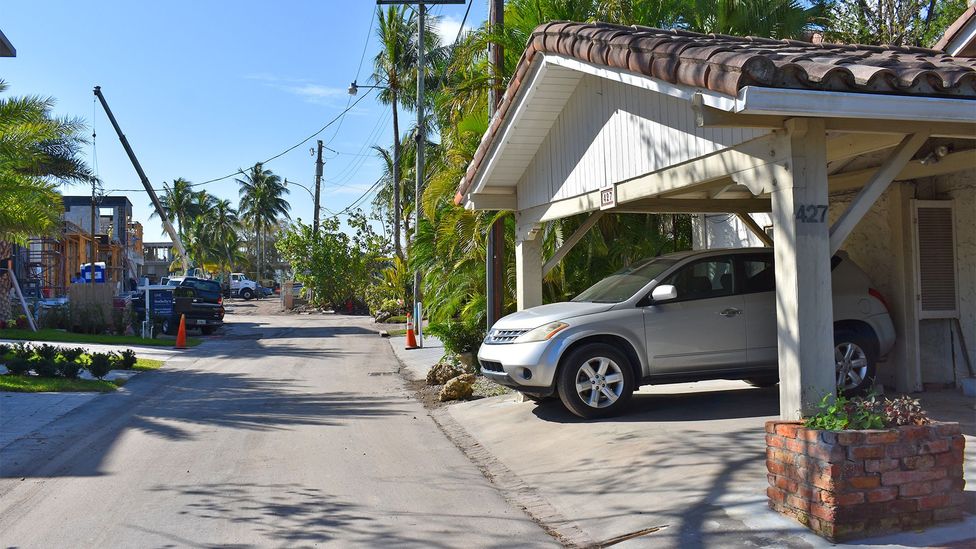
When every foot of elevation matters, even raising a driveway – every bit the owners of this Fort Lauderdale holding have done – tin can assist keep holding dry (Credit: Amanda Ruggeri)
On a nearly 2-hour tour of Fort Lauderdale's adaptation strategies, the city's head of sustainability, Nancy Gassman, points out incremental differences in elevation: slight rolls in the sidewalk or paving that unremarkably go unnoticed. "That might seem weird that I'm pointing out a couple of anxiety departure," she says. "But a couple feet in due south Florida – information technology's time. Superlative is time for us."
Not only are body of water levels rising, but the stride seems to be accelerating. That's been noted earlier – but what information technology means for s Florida was but recently brought home in a University of Miami report. "Afterward 2006, bounding main level rose faster than before – and much faster than the global rate," says the pb author Shimon Wdowinski, who is at present with Miami's Florida International University. From 3mm per year from 1998 to 2005, the rising off Miami Beach tripled to that 9mm rate from 2006.
An uptick also happened between the 1930s and 1950s, says Wdowinski, making some question whether this is a similar oscillation. Merely that's probably wishful thinking. "It's not necessarily what we see now. This warming of the planet has been growing for a while," he says. "Information technology'southward probably a unlike process than what happened 60 years agone."

Like other popular areas including Sunny Isles and Hollywood Beach, Miami Embankment is a narrow barrier island with the ocean on ane side (Credit: Alamy)
"Can nosotros definitely say information technology's the ocean warming?" says Sweet, who has authored several sea-level ascension studies. "No. Only is it indicative of what we'd expect to see? Yes."
Modelling specific future scenarios is hard – partly because scientists are still collecting and analysing data, partly because there are then many variables. What if the US or Red china reverses its trend on stabilising emissions? What if a major volcano erupts? What if a glacier melts more rapidly than expected? But enough credible projections have been done to put together a range of scenarios that researchers are confident nearly.
One graph compiled in 2015 by the Southeast Florida Regional Climate change Compact, a non-partisan initiative that collates expertise and coordinates efforts across Broward, Miami-Dade, Monroe and Palm Beach counties, is especially revealing (run into below). At the lesser is a dotted green line, which rises slowly. Before y'all go optimistic, the footnote is business firm: "This scenario would require significant reductions in greenhouse gas emissions in order to exist plausible and does not reflect current emissions trends." More than probable is the range in the middle, shaded blue, which shows that a 6-10in (15-25cm) rise in a higher place 1992 levels is likely by 2030. At the meridian, the orangish line is more severe nevertheless, going off the chart – to 81 inches (206cm) – by the end of the century.
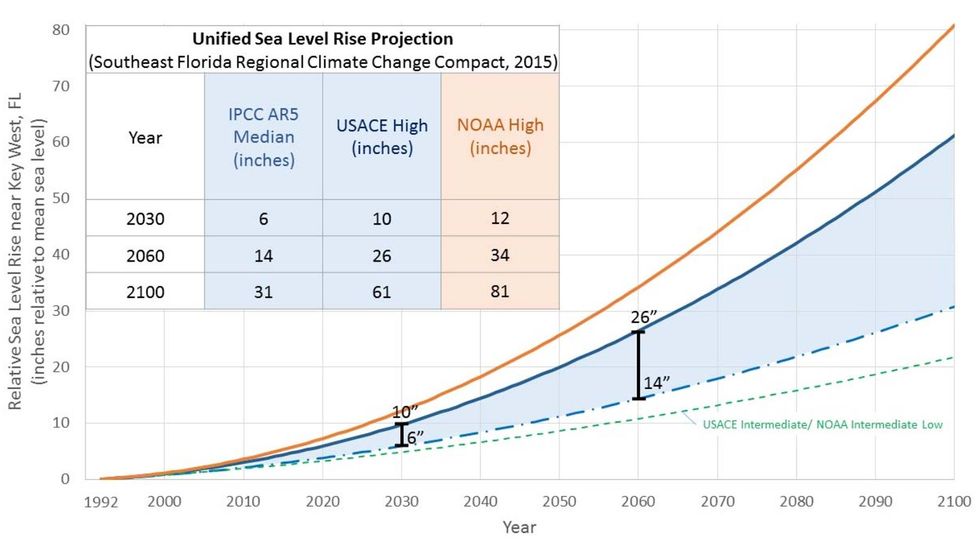
This often-used range of estimates puts a half dozen-10in rise by 2030 every bit a likely scenario (Credit: Southeast Florida Regional Climatic change Compact)
But as more than information comes in, even the worst-example estimates may turn out to exist too low: for case, researchers recently discovered that ice is melting more rapidly than expected from both Antarctica and Greenland, plus gained a amend understanding of how melting ice sheets actually affect sea-level rise. "The unlikely scenarios are now, all of a sudden, condign more than probable than they once were thought to be," says Sweet.
The well-nigh dramatic impacts may not be felt for 50 or 100 years. Merely coastal communities are already experiencing more than storms and extremely loftier tides known as king tides. In the aforementioned study, Wdowinski institute there were a full of 16 overflowing events in Miami Beach from 1998 to 2005. From 2006 to 2013, in that location were 33.
Although the timing of king tides results from the positions of the Sun, Moon and World, rise seas heighten their consequence. At extreme high tides, water levels have surged to an inch below the Intracoastal Waterway, says Jennifer Jurado, Broward County's chief resiliency officer. "Once that'southward breached, you're open to the bounding main – the supply of water is endless. The arrangement is really at capacity. These are flood weather condition, even with only the loftier tide and supermoon… You see men in business organisation suits trying to trudge through water."

Taken in 2012, earlier Miami Beach's current initiatives, this photograph shows one of the city'southward sidewalks during a flood (Credit: Alamy)
Even without floods, the rise h2o table affects everything. The cities here are built on porous limestone. The water doesn't just come over seawalls; information technology seeps up from beneath the streets. Virtually ninety% of the drinking water in due south Florida comes from aquifers, and these are finding their fresh water pushed further and farther inland every bit the common salt water exerts more and more pressure. Take Hallandale Beach, a small city of merely nether 40,000 residents. Saltwater already has breached five of the viii freshwater wells that the metropolis draws from, says Vice Mayor Keith London. And around a quarter of Miami-Dade residents employ septic tanks. If these don't remain in a higher place the water table, the result could be thoroughly unpleasant.
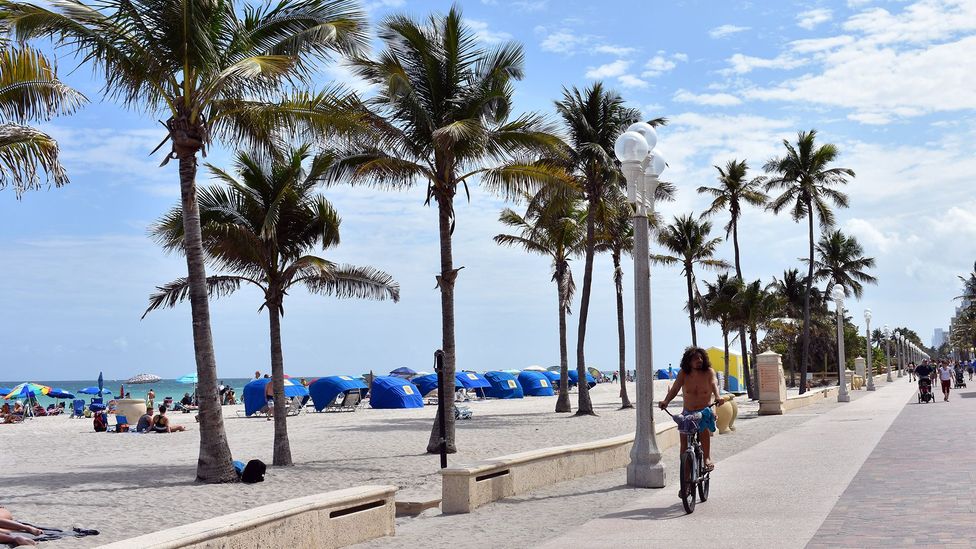
Ascent sea levels besides create a potential problem for Florida'southward beaches (Credit: Amanda Ruggeri)
Another event is beach erosion. Florida's sand may exist one of its biggest draws for tourist dollars, but it, too, is vulnerable: though sand never stays put, ascension bounding main levels and worsening storms mean the need to replenish is intensifying. A massive boondocks-by-town projection is currently underway; Miami Beach (which, famously, was manmade from the showtime) just wrapped up its 3,000ft (914m) section, to the tune of $11.9 1000000.
Of course, another part of the problem is that south Florida is built on a swamp. "The only reason we live here is we learned how to bleed it, we learned how to kill mosquitos, and we created air conditioning," says Jim Murley, main resilience officer for Miami-Dade County. Residents cut canals to drain inland areas, using the fill up to raise the land and build properties. These canals are now open doors for tidal flooding and storm surge. They also cut downward mangrove forests and levelled sand dunes – both natural barriers to flooding.
"There is going to need to exist a very serious conversation virtually how we deal with this," says George Vallejo, the mayor of North Miami Beach. "The development that has happened hither over the final twoscore or 50 years has not been helpful to this situation. We've paved over a lot of the Everglades, we've paved over a lot of greenage.
"We've washed a lot of things that, in retrospect, nosotros would accept washed differently, knowing what we know at present."
*
That's the bad news. But there'southward good news, says Gassman, whose no-nonsense demeanour and doctorate in marine biology (with a focus on coastal ecosystems) makes her specially convincing. "That's all if nothing changes. I recollect that's another thing that the public doesn't necessarily empathise: the predictions that they're hearing, time and time again, are if we practise zero. But we're not doing nothing."
That's point i. Point two is that the topography of the area isn't quite what you'd expect. She brings out a map of Fort Lauderdale dotted with squares of purple and orange. Purple means an expanse is likely to exist underwater at 2ft (61cm) of ocean level ascent; orangish ways it's possible. A surprisingly small-scale amount of the map is splashed with colour. And the at-risk areas – which are mostly by the bay, non the ocean – aren't where you might recall. "It's not the whole city," she says. "While there are problems in some areas, we'll accept to adjust, merely these areas are non in places you'd expect – and we'll have time to address some of these issues."
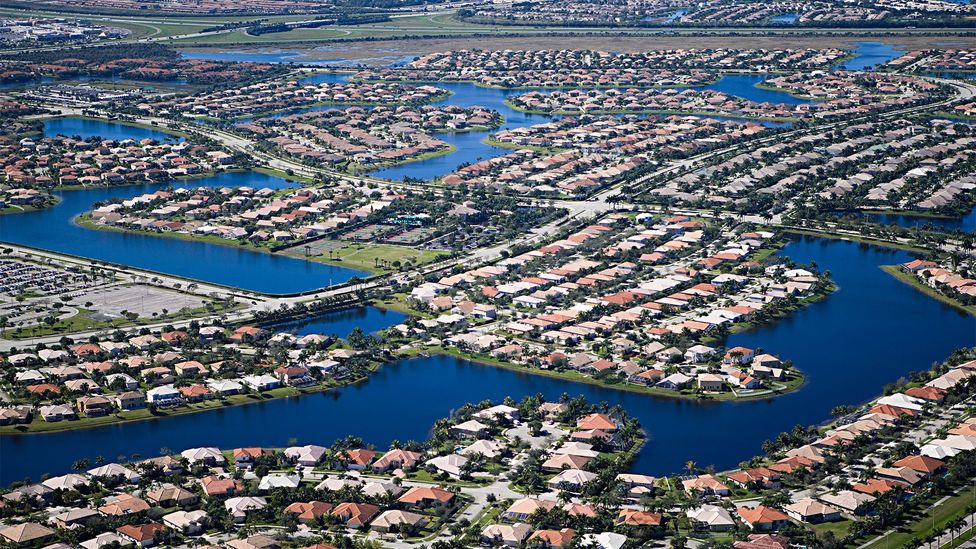
Fort Lauderdale's canals make some of its neighbourhoods especially vulnerable (Credit: Alamy)
Non every community might exist so lucky. Play the inundation game with Noaa's perversely addictive mapping tool in Hollywood, just 10 miles (16km) south of Fort Lauderdale, and you'll notice that the aforementioned 2ft (61cm) rising could put streets and most properties of an entire square-mile swathe underwater – non insignificant for a city measuring just 30 sq miles (78 sq km). (Hollywood too has its own intervention programme underway, including the installation of 18 flap gates to go along seawater from coming upward through the drainage organisation). Even so, it'southward a good reminder that the problem, as overwhelming as it seems, can be broken down into smaller pieces.
Which is exactly what Gassman and others are trying to do. Touring the city with Gassman is to see it in an entirely new way: not simply a city of graceful mansions and pretty canals, only of seawalls that are leaking or too curt, fire hydrants that are made of fe ("a fundamental, emergency-based infrastructure that's made out of a fabric that's potentially corrosive from saltwater"), drains that are overflowing and electrical boxes that need to be raised.
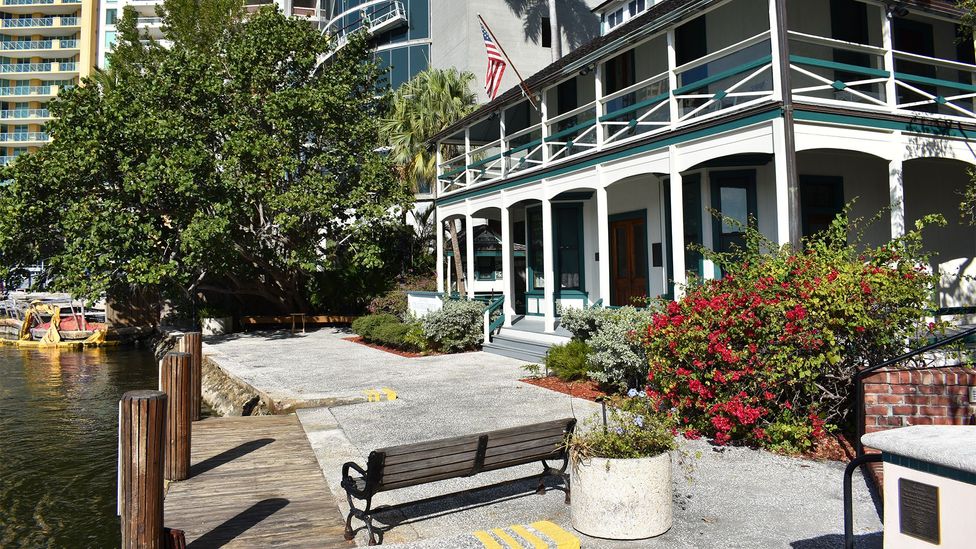
During king tides, the water has come upwards to the steps of Fort Lauderdale's virtually 125-yr-former Stranahan Business firm, shown hither (Credit: Amanda Ruggeri)
"Run across, those cars are disappearing from view," she says, pointing to the dip in the road in front end of u.s.a.. We turn onto Isle of Capri Bulldoze. "Expect what'due south happening. Look how far I'chiliad going to go down. This area floods all the time."
Fort Lauderdale is dubbed the Venice of America. That'south supposed to be because of its 165 miles (266km) of canals, merely contempo flooding has made the nickname more than on the olfactory organ than residents would like.
For both Fort Lauderdale and other communities across due south Florida, the principal problem is drainage. The systems here were designed to let stormwater drain into the ocean when it rains. Because homes and gardens are higher than the crown of the road, the streets inundation first in a tempest, past design. Water runs into the storm drain and is piped into the ocean or waterways that lead in that location.
At least, that's what is supposed to happen. With body of water levels now frequently higher than the exits to the run-off pipes, saltwater is instead running up through the arrangement and into the streets. To make matters worse, when the sea gets fifty-fifty higher, it tin breach the seawall, flood people'due south yards and flow downward to the road – where it stays.
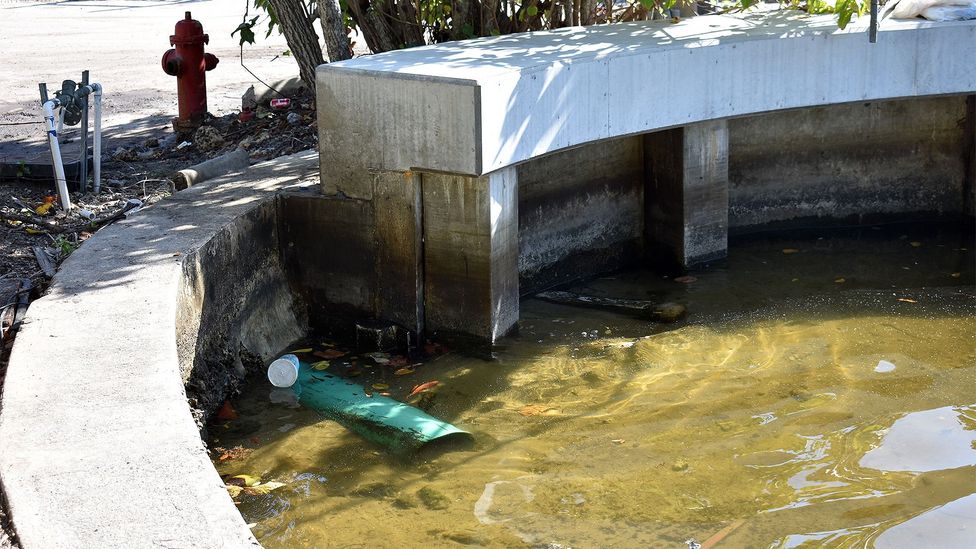
This outfall shows a common issue: correct now, it is lower than the water level, meaning information technology can't drain (Credit: Amanda Ruggeri)
Since 2013, Fort Lauderdale has been installing tidal valves to deal with the problem. Each of the one-way valves, which allows stormwater through merely not saltwater, looks like a large rubber tube and tin be fastened inside the storm drains. Gassman pulls one out to evidence me. "If y'all stick your manus in there and push a niggling bit, come across how information technology opens?" I practise. "Correct in that location, you were fresh water. Now yous're well-nigh to be salt water." She flips the valve around. I push button: sure enough, it'south a no-go.
In some areas, the valves lone accept been enough. But there'southward a grab: the floodwater nonetheless tin can't exit if the tide is above the level of the outflow pipes. That happened early on at one of the start places they installed a valve, Gassman says. A king tide came over the tops of the seawalls, flooded the street – and then remained higher than the outfall. "The valve wouldn't open. So the roads stayed flooded 24/seven," she says. "We have had complaints that the valves aren't working. But no. The valves are working."
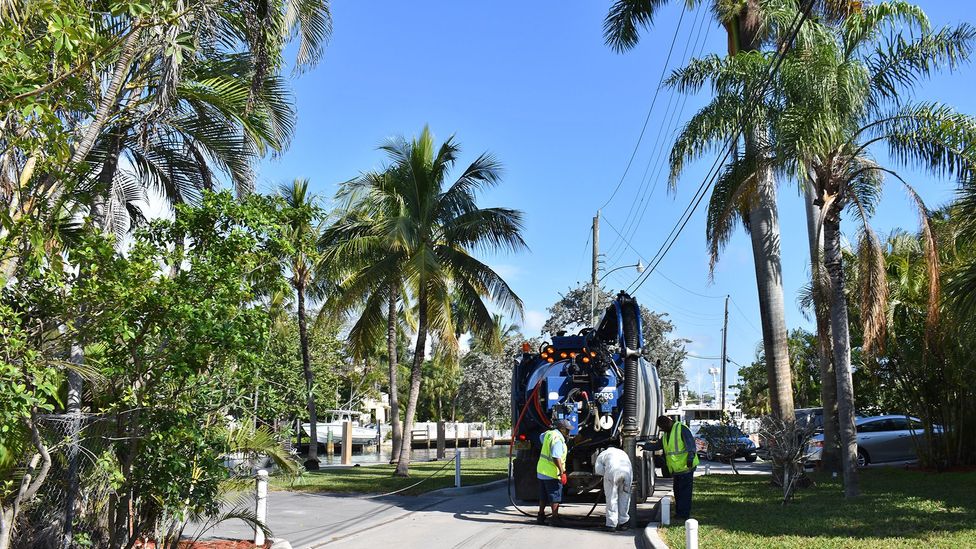
As these workers testify, each valve comes with more than of an expense than its buy cost; it also needs to be regularly inspected and maintained (Credit: Amanda Ruggeri)
Despite the limitations of the valves, it doesn't have an engineer to figure out that raising seawalls would fix flooding that resulted from high sea levels, if not from rain. But until recently, Fort Lauderdale had a height requirement for seawalls that was a maximum, non a minimum – for aesthetic reasons. Though some now exercise specify a minimum height, enforcement remains difficult. A new seawall runs from $600 to $ii,000 for a linear human foot; adding a 12in (30cm) cap costs virtually $60 per foot. For the average homeowner, a seawall measures 75-100ft (23-30m). "How are yous going to force everyone to put in money?" asks Gassman.
It turns out you can't, at least for now. Last yr, Fort Lauderdale proposed that everyone should be made to enhance their seawalls to a certain meridian by 2035. Thanks to opposition from the public, the proposal failed. Instead, belongings owners are required to go on their seawalls in a state of good repair. Someone can be reported to the authorities if their seawall is breached by the tide, only the specific new height requirement but kicks in if someone came to inquire for the permit – which is required to do significant repairs, or to build a new wall. And Fort Lauderdale makes an interesting examination instance: if costs seem prohibitive in this relatively well-off surface area, it's not going to piece of work in s Florida'southward less affluent communities – some of which also are suffering from similar flooding.
Despite Fort Lauderdale'due south best efforts, seawalls hither remain a patchwork of heights and states of repair. At Cordova Route, Gassman and I look over the finger isles pointing into the Stranahan River. Across the road from the marina, one firm has bright-dark-green grass: it's new, put downward after a flood last spring swamped their property with table salt water.
Gassman points to an older house on the corner. Their seawall is most a foot lower than their neighbour's. "That foot of deviation allows water to run over their property and alluvion the route," she says. "That one property, if we could fix that seawall, we could reduce a lot of flooding, right here."
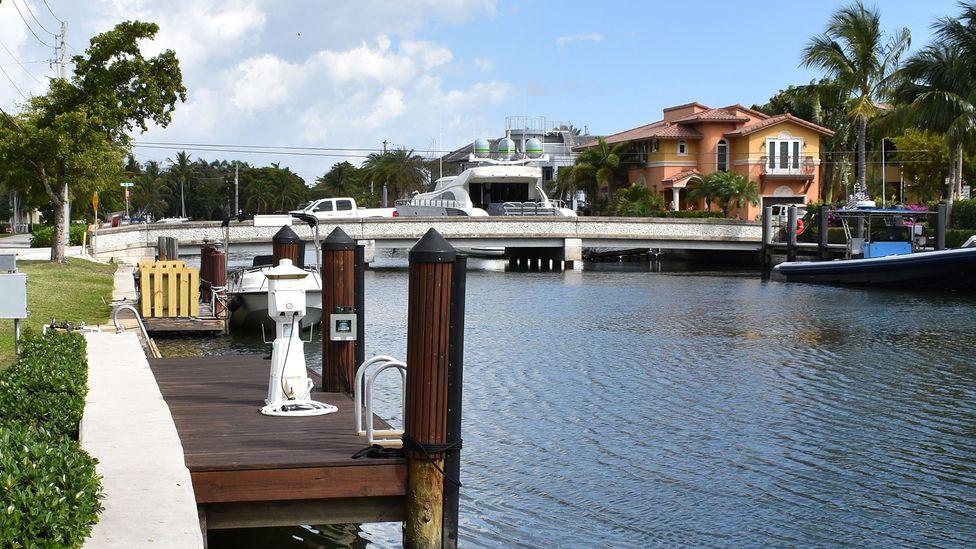
With its varying seawall heights, new decks and bridge, this corner of Fort Lauderdale shows the domino effect of irresolute one piece of infrastructure (Credit: Amanda Ruggeri)
It's not only residents who need to make changes. The urban center as well owns a seawall along this stretch; information technology, likewise, was breached recently. Replacing the virtually half-mile stretch could cost upward to $v million. Simply getting the funds is only the kickoff claiming. The end of the seawall meets a bridge. If you enhance the seawall ii more than feet, what exercise you practise with that bridge to protect information technology? And what about the docks that residents are currently allowed to have here, all of which will accept to be re-washed? "The people that live hither want a solution and they desire it at present," says Gassman. "But there's both a public and a individual cost. And changing ane piece of infrastructure starts to domino into needing to alter all sorts of things."
As well as seawalls, cities are investing in pumps. Many have put pump stations in the worst-hit neighbourhoods. But merely Miami Beach has adopted an integrated, major pumping system as part of an aggressive overall defence force strategy. Starting in 2013, the programme – which Torriente estimates will cost betwixt $400 and $500 million – is multi-pronged. Pump stations have sprouted across Dusk Harbour, an industrial-turned-hip neighbourhood on the bulwark island's bay side, and are moving due south.
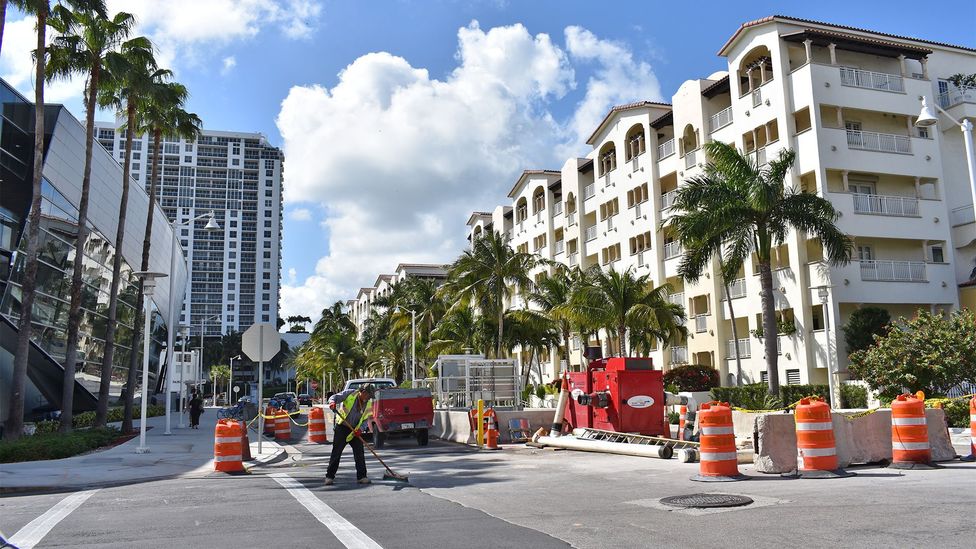
A maintenance worker repairs ane of the pump stations in Dusk Harbour, the starting time neighbourhood in Miami Beach to launch the city'south defense force strategy (Credit: Amanda Ruggeri)
Roads are being raised, too, sometimes by up to 2ft (61cm), to an elevation which the Southeast Florida Climate Meaty's projections put as a probable sea level tiptop around 2065. Seawalls are being raised to a new minimum – something that residents in Miami Beach were more amenable to than in Fort Lauderdale. The city also is requiring that all new properties build their first floor higher.
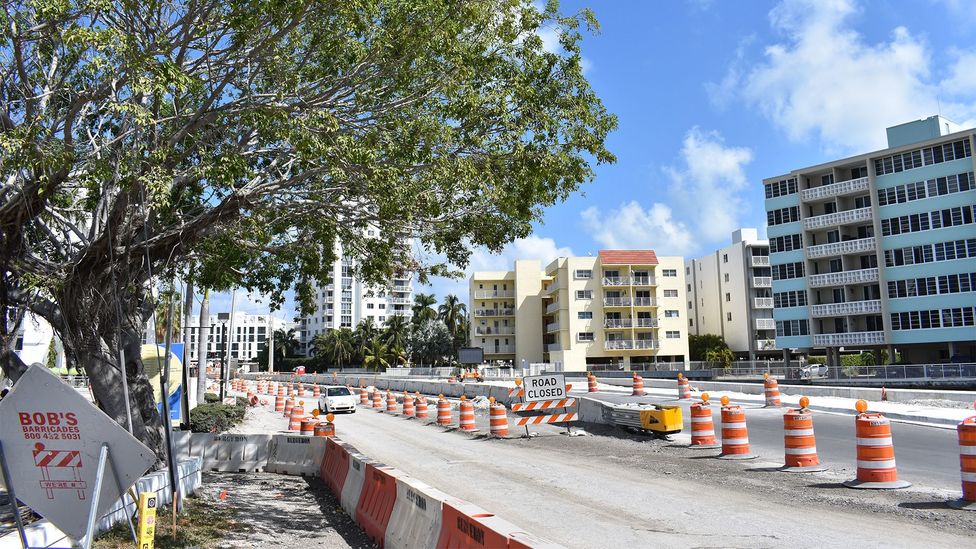
One of the roads in Miami Beach being raised past about 2ft (Credit: Amanda Ruggeri)
It'due south an ambitious agenda. And information technology's i that'south working. Areas where roads accept been raised and pumps installed take been much drier. But, as Gassman noted, it's not enough to change one piece of infrastructure without irresolute everything else. In this case, what happens when you raise a road without raising all of the properties around it? Water can become into the properties.
That'south not supposed to happen when the pumps work. Only they can neglect. Antonio Gallo's Sardinia Enoteca Ristorante is 1 of a number of businesses that take institute their footing floors are now beneath the current road and sidewalk height. Terminal year, the pumps failed to kick in later a brief flow of pelting; the restaurant flooded, with diners stuck inside. When Gallo went to file his insurance claim, it was turned down. According to the Federal Emergency Direction Bureau (Fema), which runs a national flood insurance plan for at-adventure business and property owners like Gallo, anything below street level is considered a basement. Until Fema changes their policy, that includes all of the businesses now beneath the raised streets. Miami Embankment is working closely with Fema to go non only Gallo'southward situation, but the general basement classification, re-assessed.
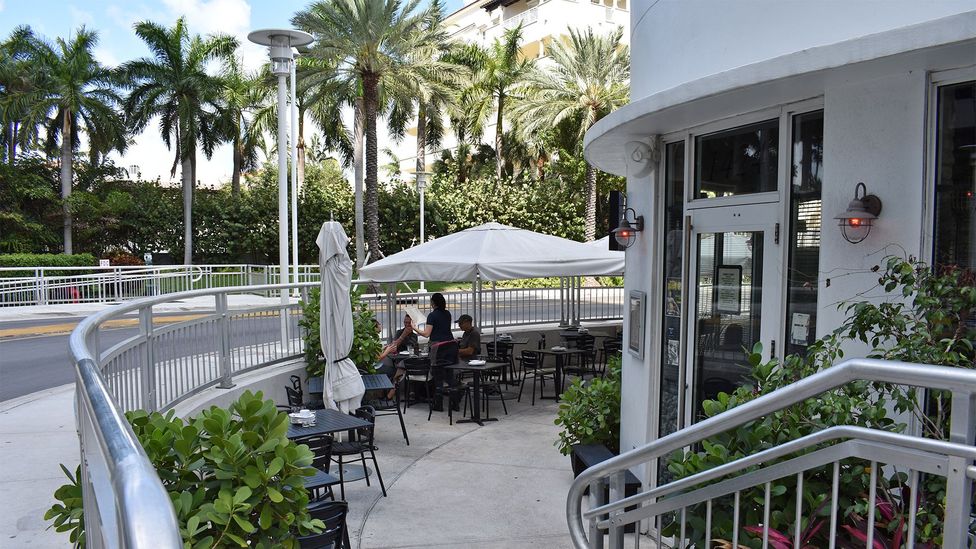
When Miami Beach raised its roads, a number of businesses, like the restaurant shown here, establish themselves below street level (Credit: Amanda Ruggeri)
Miami Embankment's efforts are the nigh aggressive. But resilience besides tin can be built into existing projects. A lot of public infrastructure is congenital to last for at to the lowest degree fifty or 75 years, and that means planning for what the world will look similar then. This is where the Compact's range of scenarios comes in handy. If you're laying down something hands replaceable, like a sidewalk, y'all could build for one of the more than optimistic scenarios. An aerodrome? It's a expert idea to go for a higher-risk scenario.
Murley, the chief resilience officer of Miami-Dade Canton (the canton'due south first), points to a 4,200ft-long (1280m) tunnel that runs from the Port of Miami to highway I395. Opened in 2014, its main objective was to re-route lorries that previously went through downtown Miami. Only the tunnel was also given a huge gate that, in a hurricane, drops downwardly to seal it at both ends. "That's an example of resilience. We wouldn't have built that 10 years ago," says Murley. "Nosotros would have congenital the tunnel, only it would have had an open forepart. Nosotros might have had sand bags."
A larger-calibration example of built-in resilience is going on at the Primal District Wastewater and Treatment Plant on Virginia Cardinal, a barrier isle where Biscayne Bay and the bounding main meet, simply east of downtown Miami. It is one of three wastewater handling plants run past the largest utility in Florida, which serves 2.3 million of the canton'south 2.half-dozen million residents. Like the other 2, it sits right by the water.
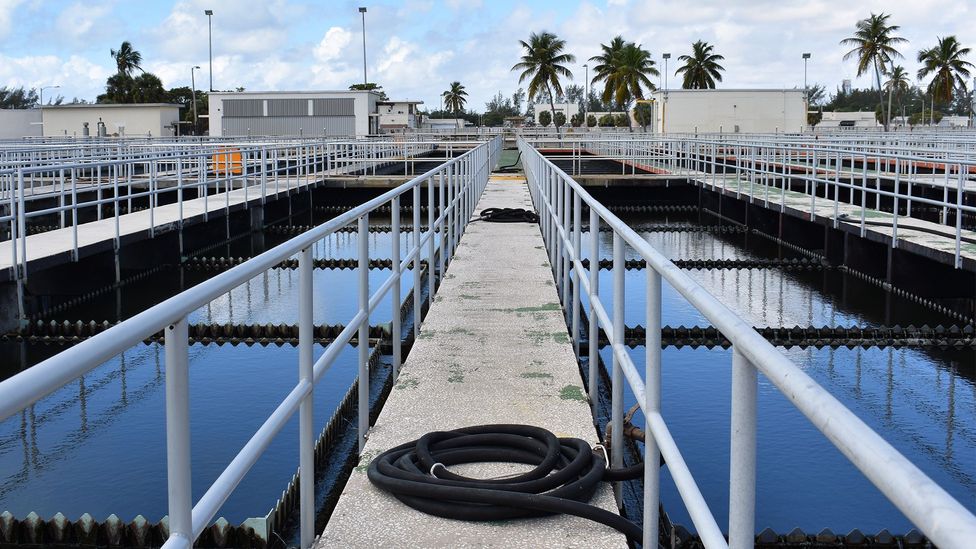
The Central Commune Wastewater and Treatment Plant is one of many aspects of due south Florida's infrastructure which is vulnerable to ascension seas (Credit: Amanda Ruggeri)
The institute already had a $500 million project on the go, making changes to comply with new Clean H2o Human action requirements. Merely because parts of the facility are expected to final 75 years or more, resilience to college ocean levels and storm surge has been baked into the blueprint. Analysts ran what would be needed in a worst-example scenario: a category five hurricane during a king tide, with maximum rainfall. "What the results told united states of america was that we ought to be building stuff at 17-20ft (5-6m) in a higher place ocean level on the coast. Our current facilities, by and big, range from x-15ft (3-4.5m)," says Doug Yoder, deputy director of Miami-Dade's water and sewer department. The new design standards prioritise edifice at those elevations first for parts of the plants that convey period – like the electrical wiring and pumps. "At least we won't take raw sewage flooding the streets," says Yoder.
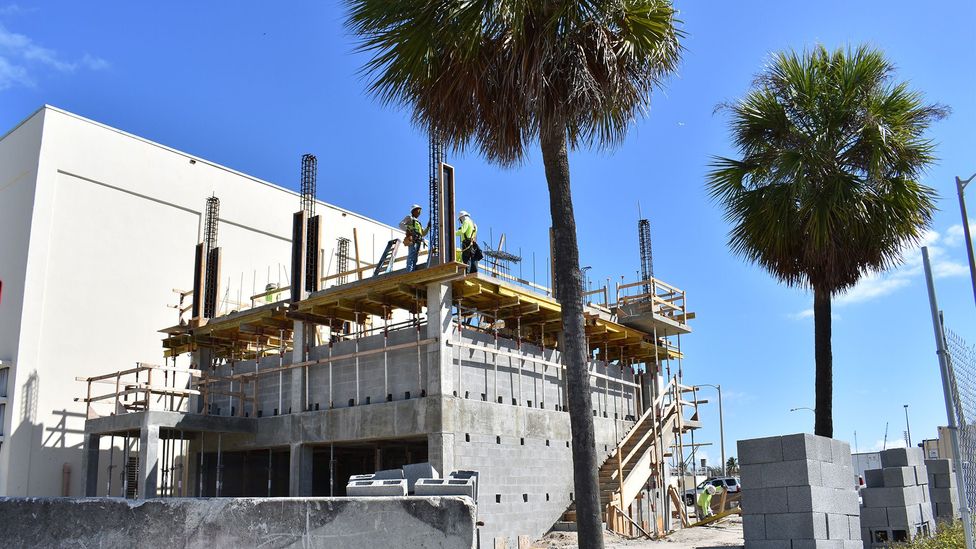
The new chlorine building, currently under construction, is designed to kickoff at 16ft (four.8m) above basis level (Credit: Amanda Ruggeri)
Individual developers will demand to think near these problems, too. According to the non-partisan research system Risky Concern, current projections put between $fifteen billion and $23 billion of existing Florida property underwater by 2050. By the cease of the century, that leaps to between $53 and $208 billion.
Just many developers aren't thinking to 2050 or 2100. Their focus is on the fourth dimension from structure to auction. In a hot existent manor market like south Florida, where a lot of investors are foreign or periodic visitors, that timeframe is far shorter – a few years at most.
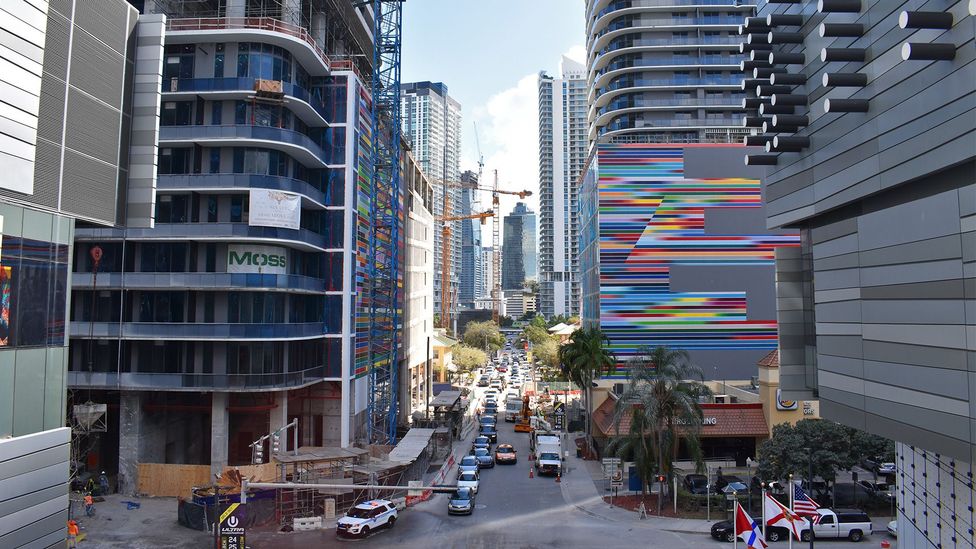
Cranes are at work and buildings under construction in Brickell, a trendy corner of Miami just over the h2o from the eye of downtown (Credit: Amanda Ruggeri)
Until regulations enforce mutual building standards, few private developers are likely to adopt resilient designs. "I recall information technology's very difficult for a developer or architect to do something the lawmaking or government doesn't require in their zoning or building code," says Wayne Pathman, a Miami-based land use and zoning attorney and the chairman of the new Metropolis of Miami Sea Level Rise commission.
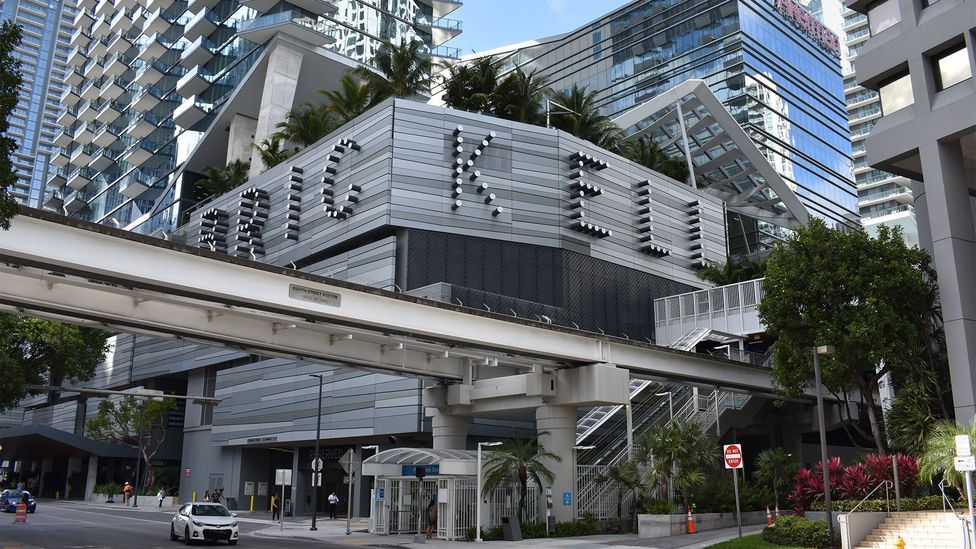
The $one billion Brickell City Centre is one of Miami's many buildings to go up in recent months (Credit: Amanda Ruggeri)
I exception is Brickell City Centre, a $1 billion, 9-acre complex of stores, restaurants, offices, condominiums and hotel in Brickell, a corner of downtown Miami filled with cranes and skyscrapers. Adult by Hong Kong-based Swire Backdrop, the complex is sleek and airy – and, says Chris Gandolfo, vice president of evolution for Swire's US operations, resilient. "Starting years ago, Swire was progressive in its thinking on rising tides," he says.
Gandolfo ticks off some of the adaptation strategies that were used: building higher than the current inundation plain; flood gates that can seal off the underground car park; an elevated seawall. It too has sustainable features like light-green roofs, native plants and what the developers have dubbed a "climate ribbon" – a walkway that captures the bay winds to cool the construction and lower energy costs, and works as a cistern to re-use rainwater for irrigation. "We may non make firsthand returns," Gandolfo says. "But I call back it'll have long-term returns."
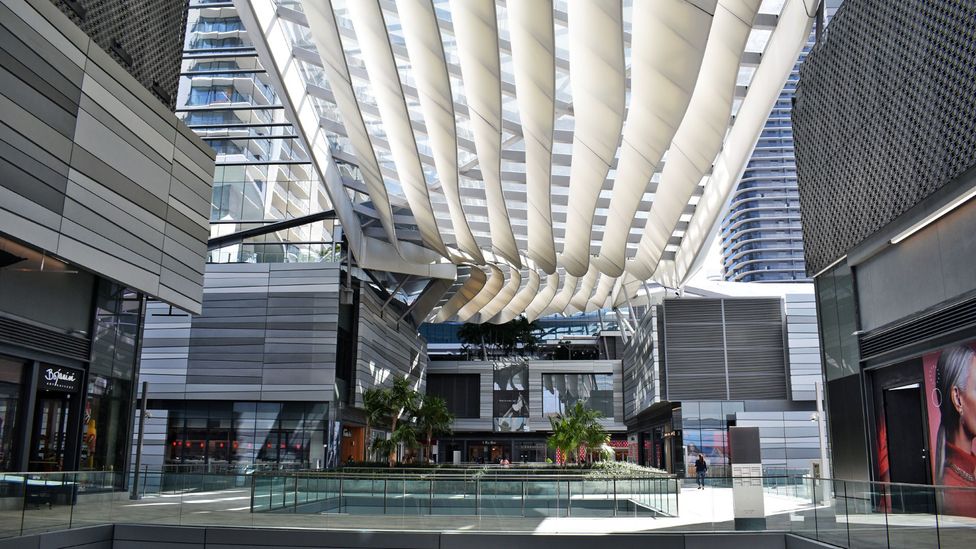
As well as sleek and airy, developers say that Brickell City Eye is resilient (Credit: Amanda Ruggeri)
All of this puts a grab-22 at the heart of south Florida's development. The state levies no personal or concern income taxes and has a low corporate income taxation, meaning property taxes provide a major source of acquirement. Just unless it is managed very advisedly, new development brings new challenges.
"Every i of these buildings that goes up expands your vulnerability and magnitude of gamble," says Kreeger. "On the flip side, you're non getting aid from the state, because the state legislature and governor are in full denial most climate change. And then you're bringing in money today which is going to assist you. Simply you're also bringing a bigger trouble tomorrow."
*
Thinking most any of this is a relatively new trend. Although scientists began speaking about sea level ascension for several decades, the topic only saw real traction amongst local governments and businesses a few years agone.
Part of the reason is that the outcome was beingness ignored by so many others. Virtually officials say that the Compact, signed in 2010, has been a major commuter in helping local governments collect the data they need and coordinate together on what to practice about it – and it was signed afterwards the realisation that, despite concrete problems that had to exist solved today, state, federal and international governments weren't doing what was needed to address them.
The Florida governor is a climate change sceptic and has directed attention away from the result. Former employees have said they fifty-fifty were told not to utter the phrase "climate alter". Ignoring the issue now appears to pervade the highest levels of US authorities: the new Environmental Protection Agency (EPA) chief doubts whether carbon dioxide plays a main role in climatic change, while President Trump recently signed an executive guild overturning emissions-slashing regulations. Draft versions of the White House upkeep suggest cutting the EPA budget by 31% and employee numbers by 20%, as well equally steep cuts to Noaa – including 26% of the funds from its Role of Oceanic and Atmospheric Enquiry and entirely eliminating the Body of water Grant programme, whose Florida section brings together 17 dissimilar universities to study sea level rise challenges and solutions.
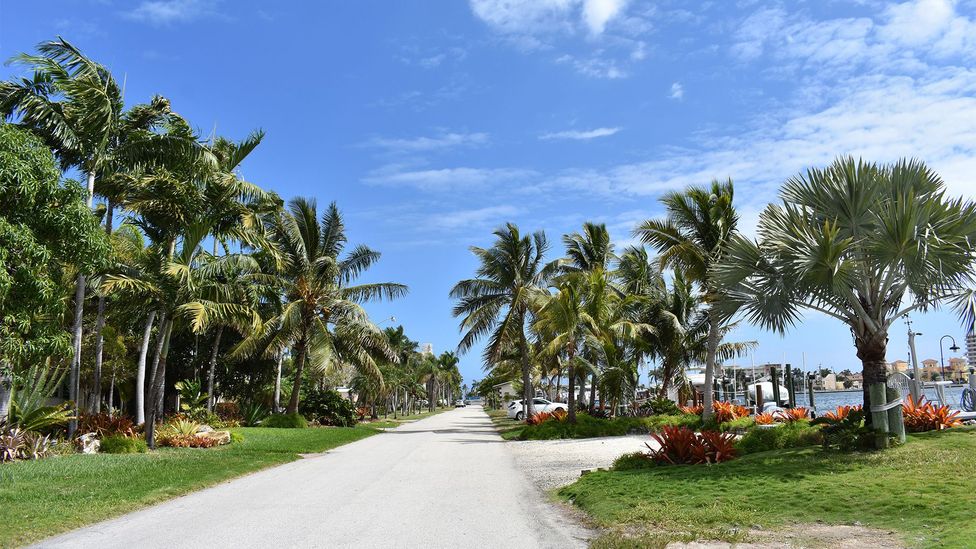
In the Due north Lake neighbourhood of Hollywood, which experiences frequent flooding, a berm has been built (at right) to endeavor to protect the houses (at left) (Credit: Amanda Ruggeri)
Local governments are forging on, but such circumstances brand the challenge fifty-fifty greater. With budgets that run in the tens of millions, not billions, local governments already need to be fiscally creative. Meanwhile, planning depends on up-to-date data – at that place's no point in raising seawalls if yous don't know how high they demand to be. And some of the almost reliable projection scenarios, equally well as sea level ascension data, is gathered from Noaa.
Yet the bear upon from these changes won't stop at party lines. Even President Trump's family isn't immune. Three anxiety of bounding main level ascension – which the range of predictions put together past Compact estimates is likely to happen within the side by side threescore years – will flood Trump'south Mar-a-Lago estate in Palm Embankment.
"Information technology doesn't matter if you're a Democrat or Republican commissioner when a neighbor calls you and tells you that their lawn is flooded," says Gassman. "The water doesn't care about politics. The water goes where the water goes. And someone who has a flooding trouble that'southward impacting their quality of life or their property values, they don't care what flavor their politician is. What they care about is that the city is thinking about it, and that they're planning to do something most information technology."
*
Some of the communities in south Florida doing the most to adapt to the furnishings of sea level rise are doing and so largely because of public pressure. In 1993, Miami-Dade put together its starting time plan to reduce carbon emissions. Inappreciably anyone came out for the committee hearing, Yoder says. Fast-forrad to 2015: a hearing on the county'southward budget was dominated by i resident after another asking why the county wasn't doing more virtually sea level rise.
And then much so, in fact, that the canton decided to hire Murley, its start resilience officer. One of his immediate tasks was to look into getting onto the Rockefeller Foundation's 100 Resilient Cities programme. Accepted cities receive funding and tailored guidance on how to make themselves adaptable to future challenges, from loftier unemployment to earthquakes and body of water-level rising.
Greater Miami is just at the offset of the process, Murley says. But he'southward not the merely one hoping that the resources made bachelor volition help guide the area far into the future. When I try to arrive touch with the commissioners or mayor of Sunny Isles, I get a recollect from Brian Andrews, a crisis PR consultant. He says sea level rise is something the city is enlightened of, but that "we're waiting for the county" to gather data and send guidelines for an activity plan. "They're getting millions and millions from the Rockefeller Foundation for this," he says. "We're a trivial city. We couldn't practice it on our ain."
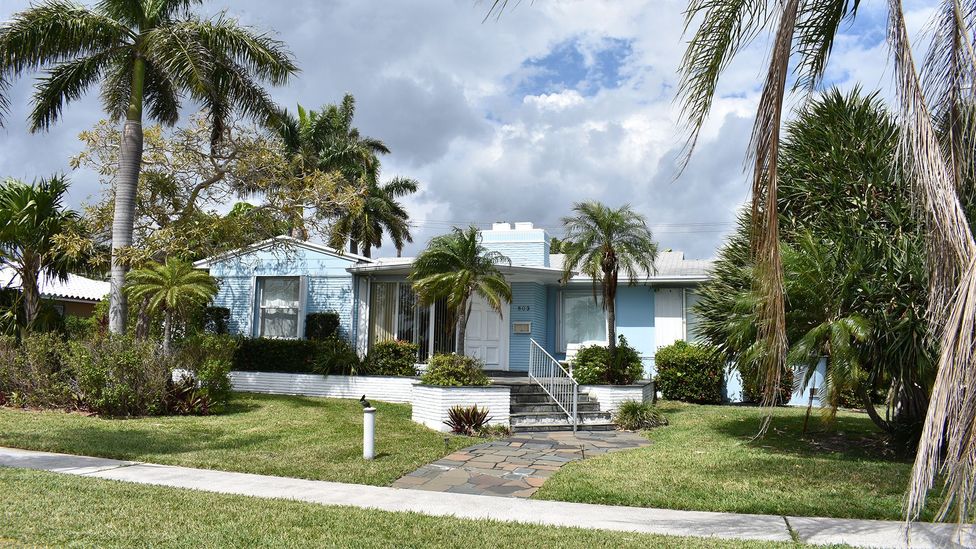
Some property owners accept taken matters into their own hands: this firm was built on a raised pad, as you tin can see from the four steps up to the door (Credit: Amanda Ruggeri)
Despite how sensation of the issue has grown in some communities – particularly those, like Miami Embankment and Fort Lauderdale, that have seen the about flooding – information technology's nevertheless common for sea-level rising to get shunted to the end of the list of priorities. "As an elected official, when I become knock on doors, resiliency and body of water level rising is never discussed," says Esteban Bovo, chair of the Miami-Dade County Committee. "It's never talked about. Information technology's crime, how much we're going to invest in constabulary, how much we're going to invest in traffic, how much we're going to invest in public safe, libraries – those are the topics of conversation."
*
Later on, I detect myself playing with the Noaa sea-level tool once again. I zoom in on Sunny Isles. At 1ft, the low-lying mangrove swamps of the Oleta River Country Park, just over the water, are submerged and the wooded backyard of the Intracoastal Yacht Order disappears. At 2ft, the St Tropez Condominiums and the newly-built Town Center Park are underwater, equally are many shops effectually 172nd Street. At 3ft, things get-go to go serious. Blue blots out the entire shopping plaza and the Epicure Market. At 4ft, the entire west side of Sunny Isles is uninhabitable. At 6ft, it'south gone. Merely the spine nearly the beach – where my father lives – remains.
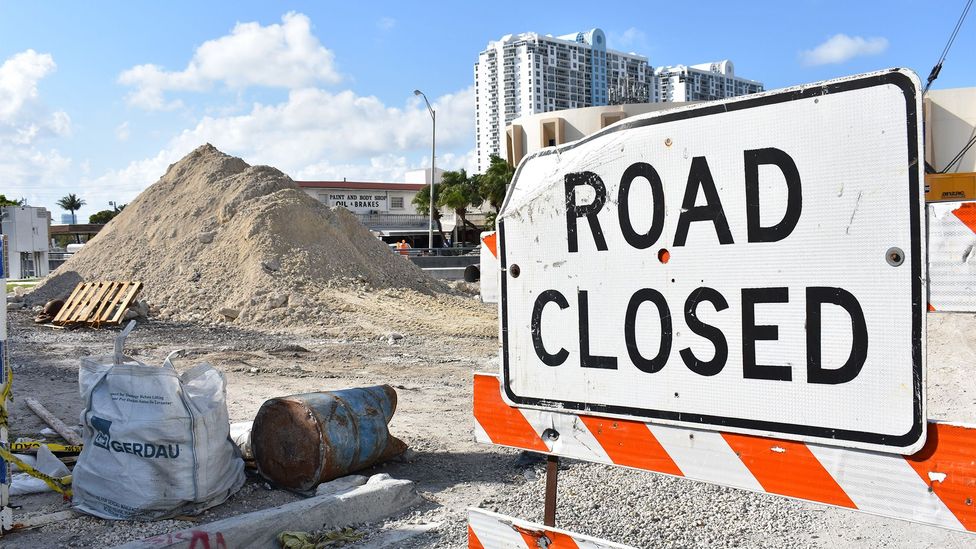
Adaptation strategies similar those beingness undertaken in Miami Beach are simply one office of the solution (Credit: Amanda Ruggeri)
Information technology's easy to wait at Meaty's range of estimates and retrieve that, since a 3ft or 4ft rise may remain fairly far off, everything volition be fine for a few more generations. But it's not. With public infrastructure – from fresh h2o to flushing toilets to roads – woven between communities, if just 1 surface area gets afflicted, others may suffer. Meanwhile, resilience is but one piece. Every bit shown past the Meaty chart's steep orangish line, if emissions proceed to rise, adaptation will go increasingly hard – if not incommunicable. And unlike raising seawalls or installing tidal valves, that, of class, tin can't be controlled by a community or region lonely. "Climate change mitigation to reduce greenhouse gases is a global consequence and has to exist dealt with globally," says Gassman. "Adaptation to the inevitable effects of climate change is a local issue."
Later, peering out the window equally my aeroplane takes off over Miami, I no longer come across the dense green squares of the city'due south western edge, the sharp skyscrapers downtown and the surprisingly slender line of barrier islands. Instead, I see what might be lost. From here, the ocean looks vast.
Only as the plane climbs, I remind myself that human innovation was enough to bleed the swamp and make Florida what it is today. Information technology was smashing enough to become me here, fifteen,000ft in the air. And information technology just might exist enough to save what I see below.
--
This story was awarded the 2019 European monetary system Announcer Award, given by the European Meteorological Society every ii years for a climatology-related piece of work of journalism.
--
Bring together 800,000+ Future fans by liking u.s. on Facebook , or follow united states of america on Twitter .
If you liked this story, sign up for the weekly bbc.com features newsletter , chosen "If You Only Read 6 Things This Calendar week". A handpicked choice of stories from BBC Future, Earth, Culture, Capital, and Travel, delivered to your inbox every Friday.
Source: https://www.bbc.com/future/article/20170403-miamis-fight-against-sea-level-rise
0 Response to "Make You Feel Love Again Sealevel"
Enregistrer un commentaire